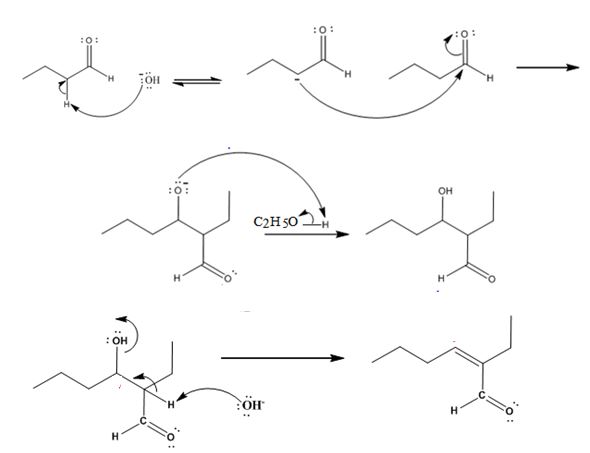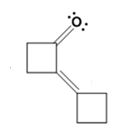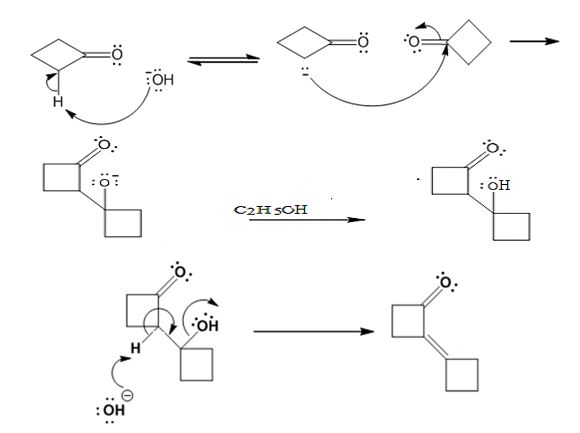
Concept explainers
a)

Interpretation:
The dehydration product formed in the addition reaction of butanal along with the mechanism of its formation is to be predicted.
Concept introduction:
The β- hydroxyl aldehyde or ketone obtained loses a molecule of water upon heating to give an α, β- unsaturated aldehyde or ketone.
To predict:
The dehydration product formed in the addition reaction of butanal along with the mechanism of its formation.
Answer to Problem 28MP
The dehydration product formed in the addition reaction of butanal is 2-ethyl-2-hexenal.
The mechanism of its formation is

Explanation of Solution
In the first step the base picks up an acidic proton from the diketone to produce the enolate anion. In the next step the nucleophilic enolate anion attacks the electrophilic carbon of the other carbonyl group in the same molecule to give an alkoxide. In the next step the alkoxide intermediate is protonated to yield the β- hydroxyl aldehyde. Removal of a proton by the base from the hydroxy aldehyde leads to the formation of α, β- unsaturated aldehyde.
The dehydration product formed in the addition reaction of butanal is 2-ethyl-2-hexenal.
The mechanism of its formation is

b)

Interpretation:
The dehydration product formed in the addition reaction given along with the mechanism of its formation is to be predicted.
Concept introduction:
Aldehydes and ketones that have α- hydrogen atom undergo aldol condensation to yield a β- hydroxyl aldehyde or ketone as the product. The reaction occurs in three steps i) Abstraction of α- hydrogen by a base to yield an enolate anion ii) Attack of the anion on the carbonyl carbon of another molecule iii) Protonation of the alkoxide intermediate.
The β- hydroxyl aldehyde or ketone obtained on heating loses a water molecule to yield an α, β- unsaturated aldehyde or ketone.
To identify:
The dehydration product formed in the addition reaction of cyclobutanone along with the mechanism of its formation.
Answer to Problem 28MP
The dehydration product formed in the addition reaction of cyclobutanone is

The mechanism of its formation is

Explanation of Solution
In the first step the base picks up a proton from the α-carbon of one cyclobutanone molecule to produce the enolate anion. In the next step the nucleophilic enolate anion attacks the electrophilic carbonyl carbon of another cyclobutanoe molecule to give an alkoxide. In the next step the alkoxide intermediate is protonated to yield a β- hydroxyketone. In the final step the base picks up a proton from the hydroxyl group that leads to the formation of α, β- unsaturated ketone.
The dehydration product formed in the addition reaction of cyclobutanone is

The mechanism of its formation is

c)

Interpretation:
The dehydration product formed in the addition reaction given along with the mechanism of its formation is to be predicted.
Concept introduction:
The reaction given is a mixed aldol reaction. Aldehydes and ketones that have α- hydrogen atom undergo aldol condensation to yield a β- hydroxyl aldehyde or ketone as the product. The reaction occurs in three steps i) Abstraction of α- hydrogen by a base to yield an enolate anion ii) Attack of the anion on the carbonyl carbon of another molecule iii) Protonation of the alkoxide intermediate.
The β- hydroxyl aldehyde or ketone loses a molecule of water when heated in the presence of a base to yield α, β- unsaturated aldehyde or ketone.
To identify:
The dehydration product formed in the addition reaction given along with the mechanism of its formation.
Answer to Problem 28MP
The dehydration product formed in the addition reaction given is

The mechanism of its formation is

Explanation of Solution
In the first step the base picks up a proton from the α-carbon of acetaldehyde as it has α- hydrogen atoms to produce the enolate anion. In the next step the nucleophilic enolate anion attacks the electrophilic carbonyl carbon of benzaldehyde to give an alkoxide. In the next step the alkoxide intermediate is protonated to yield a β- hydroxyaldehyde. In the final step the base picks up a proton from the hydroxyl group that leads to the formation of α, β- unsaturated aldehyde.
The dehydration product formed in the addition reaction given is

The mechanism of its formation is

d)

Interpretation:
The product formed in the addition reaction given along with the mechanism of its formation is to be predicted.
Concept introduction:
In intramolecular aldol reactions dicarbonyl compounds such as diketones react with a base to yield a cyclic enone as the products. The reaction occurs in four steps i) Abstraction of α-hydrogen by a base to yield an enolate anion ii) Attack of the anion on the carbonyl carbon in another molecule iii) Protonation of the alkoxide intermediate. iv) Loss of water from the keto alcohol upon heating.
To identify:
The product formed in the addition reaction given along with the mechanism of its formation.
Answer to Problem 28MP
The product formed in the addition reaction given is

The mechanism of its formation is

Explanation of Solution
In the first step the base picks up an acidic proton from the diketone to produce the enolate anion. In the next step the nucleophilic enolate anion attacks the electrophilic carbon of the other carbonyl group in the same molecule to give an alkoxide. In the next step the alkoxide intermediate is protonated to yield a hydroxyl ketone. In the final step the base picks up a proton from the hydroxyl group that leads to the formation of α, β- unsaturated aldehyde.
The product formed in the addition reaction given is

The mechanism of its formation is

Want to see more full solutions like this?
Chapter 23 Solutions
Organic Chemistry
- Predict the product(s) and provide the complete mechanism for each reaction below.arrow_forwardIn light of the fact that tertiary alkyl halides undergo spontaneous dissociation to yield a carbocation plus halide ion (see Problem 10-45), propose a mechanism for the following reaction.arrow_forwardUse your general knowledge of alkene chemistry to suggest a mechanism for the following reaction.arrow_forward
